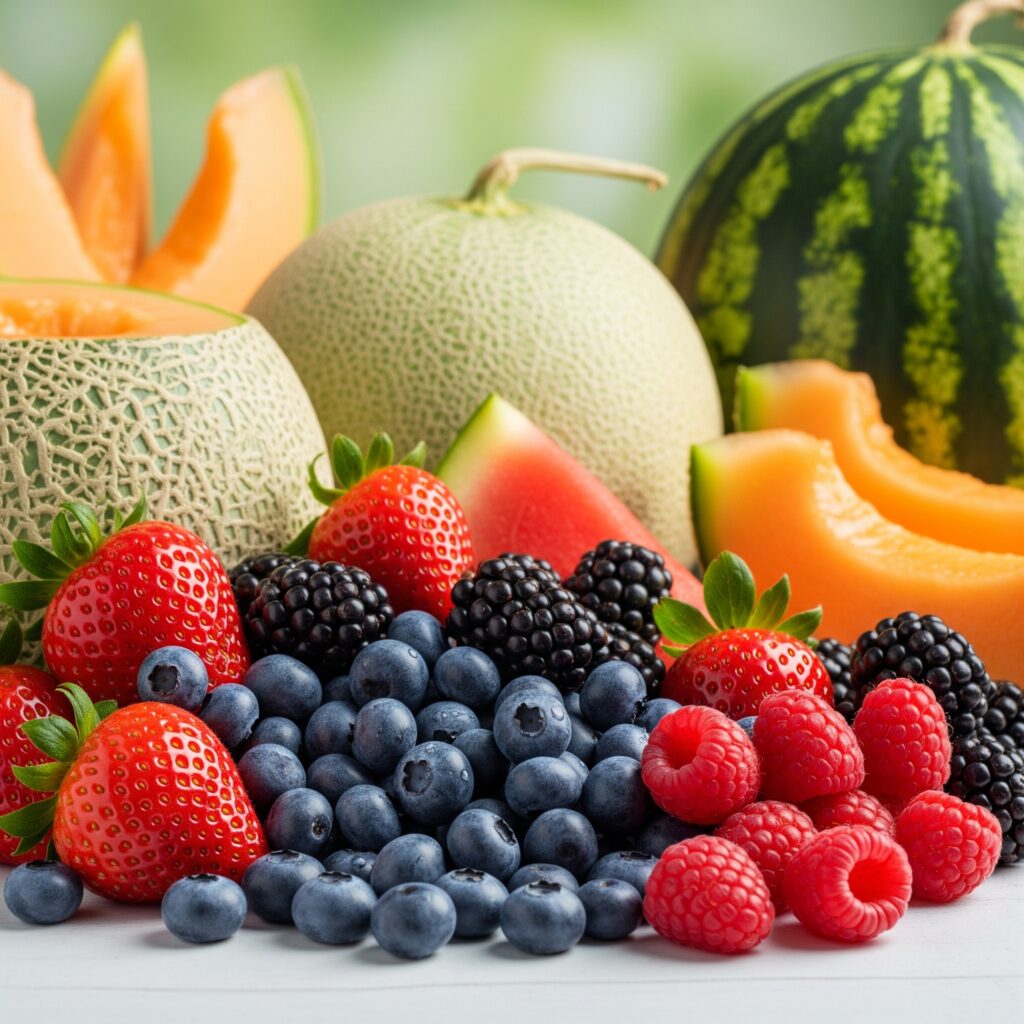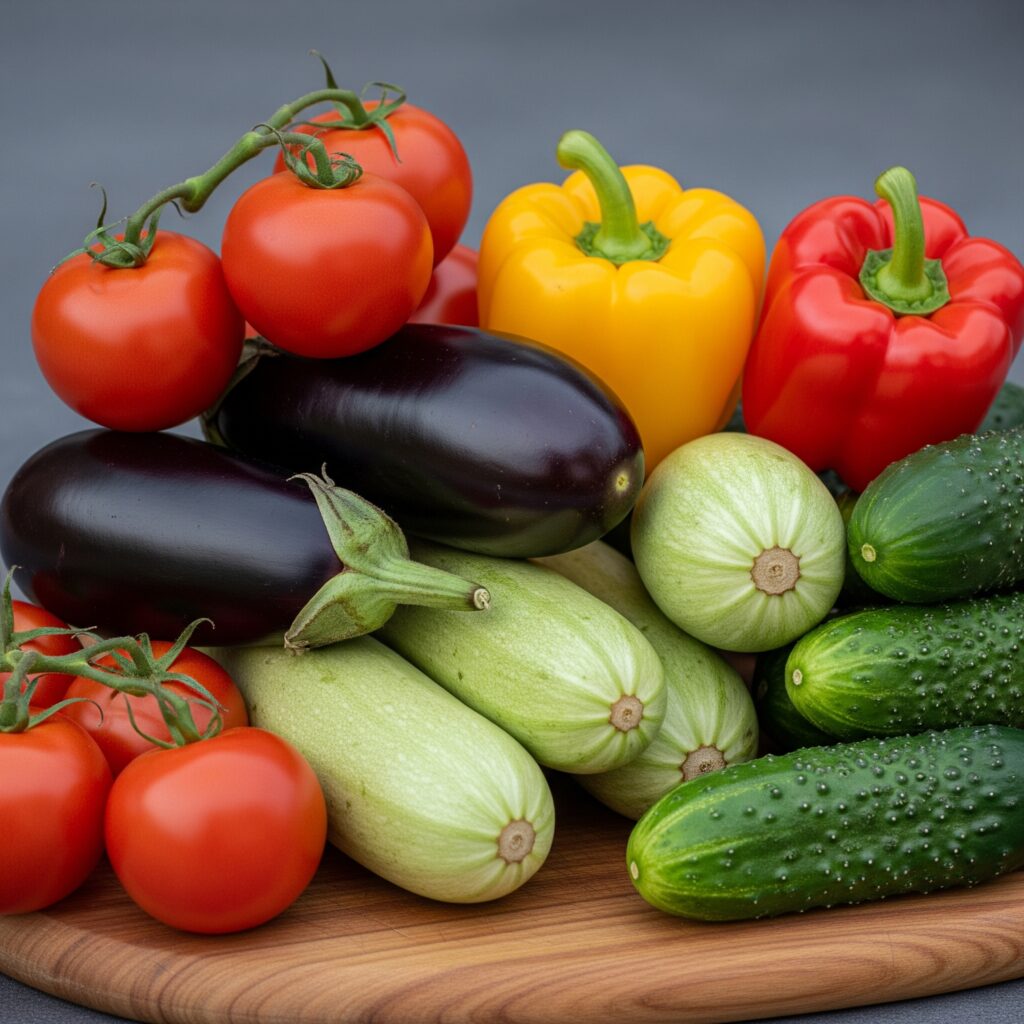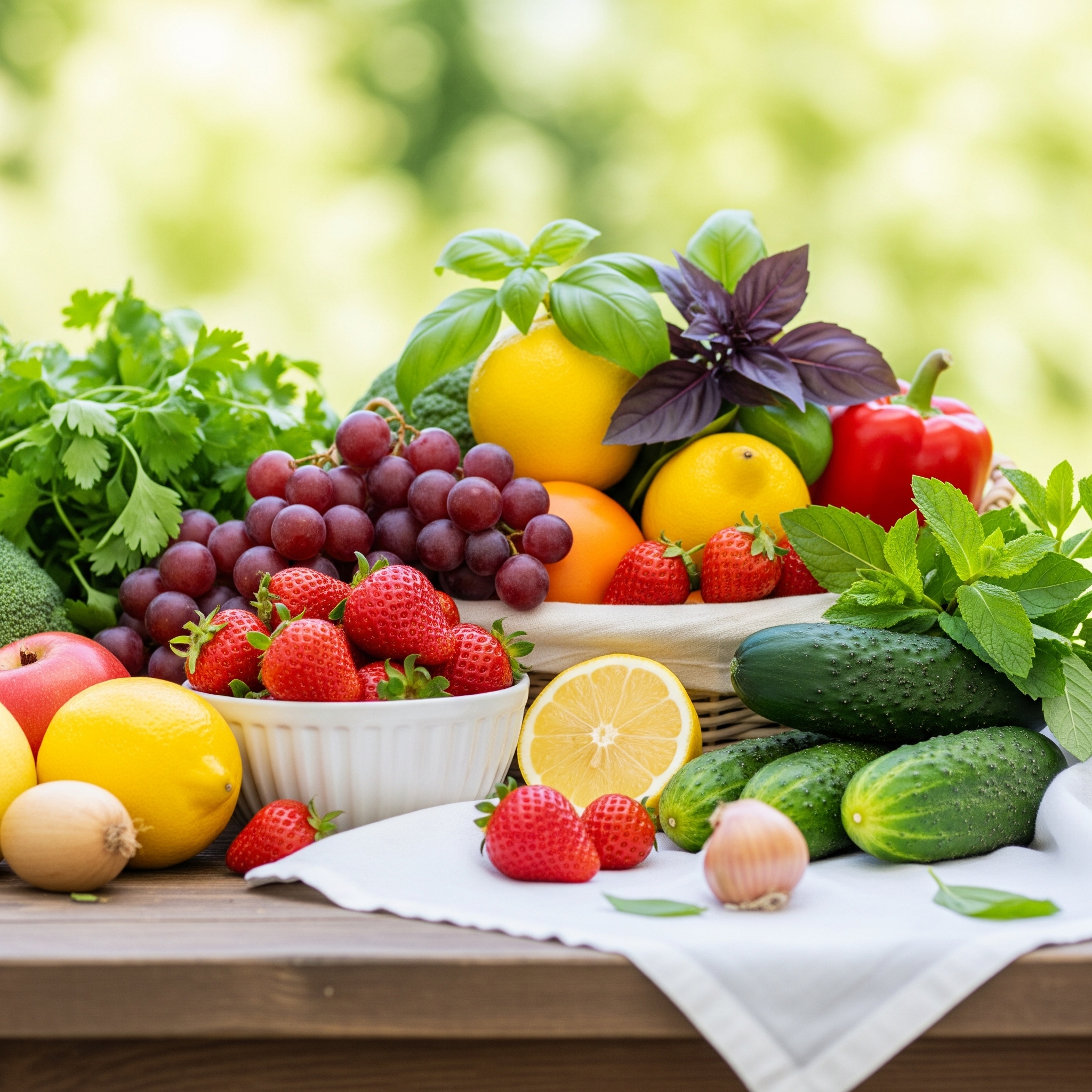As the sun climbs higher and the days stretch longer, a vibrant transformation occurs in gardens and farmers’ markets alike. Summer doesn’t just bring warmer weather; it ushers in an unparalleled bounty of fresh, flavorful produce that sings with the season’s energy. From succulent berries bursting with sweetness to crisp, hydrating vegetables, summer produce offers a culinary playground that delights the senses and nourishes the body.
Embracing seasonal cooking in summer isn’t just a trend; it’s a practice rooted in flavor, nutrition, and sustainability. When produce is harvested at its peak ripeness, it’s at its most flavorful, packed with essential vitamins, minerals, and antioxidants, and often more affordable. Beyond that, buying local and seasonal supports regional farmers and reduces the carbon footprint associated with long-distance transportation. This blog post will guide you through the stars of summer’s harvest, from luscious fruits to versatile vegetables and aromatic herbs, and provide you with creative, delicious ideas on how to incorporate them into your daily cooking for maximum enjoyment and health benefits.
Why Eat Seasonally in Summer?
The allure of summer produce goes far beyond its aesthetic appeal. There are compelling reasons why eating what’s in season, particularly during the summer months, is a smart choice for your health, your palate, and the planet:
- Peak Flavor: Produce picked at its prime ripeness, rather than forced to ripen during transit, simply tastes better. Think about a sun-warmed, juicy tomato from a local farm versus a pale, mealy one from a grocery store in winter. The difference is astounding. The natural sugars and aromatic compounds are at their peak, delivering an explosion of taste.
- Nutritional Superiority: Studies show that fruits and vegetables harvested in season contain higher levels of vitamins, minerals, and antioxidants compared to their off-season counterparts. They haven’t lost nutrients during long storage or transportation. For example, summer berries are renowned for their high Vitamin C and antioxidant content.
- Cost-Effectiveness: When produce is abundant due to peak harvest, supply often outstrips demand, leading to lower prices. This makes healthy eating more accessible and budget-friendly.
- Environmental Benefits: Eating seasonally, especially from local sources, significantly reduces the carbon footprint associated with food production. Less transportation, less need for artificial ripening, and less energy consumption contribute to a more sustainable food system. Using reusable produce bags at the market can further reduce your environmental impact.
[REUSABLE_PRODUCE_BAGS] - Variety and Culinary Inspiration: Seasonal eating encourages culinary creativity and introduces variety into your diet. Each season brings a fresh palette of ingredients, inspiring new recipes and cooking methods that keep your meals exciting and diverse.
The Stars of Summer Produce: A Guide to the Season’s Bounty
Summer offers an incredible array of fruits, vegetables, and herbs. Let’s explore some of the absolute best:
A. Luscious Summer Fruits

- Berries (Strawberries, Blueberries, Raspberries, Blackberries):
- Flavor Profile: Bursting with sweet and tart notes, from the honeyed sweetness of a ripe strawberry to the tangy punch of a blackberry.
- Nutritional Benefits: Powerhouses of antioxidants (anthocyanins are particularly abundant), Vitamin C, and fiber. Blueberries, in particular, are celebrated for their brain-boosting properties.
- Selection & Storage: Look for plump, firm berries with vibrant color, free from mold. Store them unwashed in the refrigerator in a single layer, or in a specialized berry keeper to extend freshness. Wash just before use.
- How to Use Them:
- Fresh: Simply enjoy them by the handful, add to oatmeal, yogurt, or cold cereals.
- Smoothies: Blend into refreshing summer smoothies. A high-speed blender is perfect for achieving a silky-smooth texture.
[HIGH_SPEED_BLENDER] - Desserts: Ideal for pies, crumbles, tarts, and parfaits. Use a classic pie dish for perfect baking.
[PIE_DISH] - Salads: Add a sweet pop to spinach or mixed green salads with goat cheese and a balsamic glaze.
- Jams & Preserves: Preserve the summer flavor by making homemade jams. A canning starter kit with mason jars is essential for this.
[CANNING_KIT] - Savory Dishes: Strawberries can be surprisingly good in salads with balsamic vinegar, and blueberries pair well with grilled chicken.
- Stone Fruits (Peaches, Nectarines, Plums, Cherries, Apricots):
- Flavor Profile: Sweet, juicy, and often slightly tangy, with a distinct pit (stone) at their center. Peaches are fuzzy, nectarines smooth, plums range from super sweet to tart.
- Nutritional Benefits: Rich in Vitamins A and C, potassium, and dietary fiber. Cherries are notable for their anti-inflammatory compounds.
- Selection & Storage: Choose fruits that are fragrant and give slightly to gentle pressure. Store at room temperature until ripe, then refrigerate. For cherries, look for firm, bright, dark fruit. A cherry pitter can make preparing large batches much easier.
[CHERRY_PITTER] - How to Use Them:
- Fresh: Perfect for eating out of hand.
- Grilled: Halved peaches or plums grill beautifully, caramelizing their sugars. Use a grill basket to prevent sticking.
[GRILL_BASKET] - Baked: Cobblers, crumbles, pies, and tarts are classic stone fruit desserts.
- Salsas: Chopped peaches or plums add a sweet counterpoint to spicy salsas for grilled fish or chicken.
- Smoothies: Blend into creamy, refreshing smoothies.
- Jams & Preserves: Excellent for preserving summer’s sweetness.
- Dehydrated: A food dehydrator can transform slices into healthy, chewy snacks.
[FOOD_DEHYDRATOR]
- Melons (Watermelon, Cantaloupe, Honeydew):
- Flavor Profile: Sweet, incredibly juicy, and supremely refreshing. Watermelon is crisp and hydrating, cantaloupe musky and sweet, honeydew subtly sweet.
- Nutritional Benefits: High in water content, making them excellent for hydration. Rich in Vitamins A and C, and potassium. Watermelon also contains lycopene, a powerful antioxidant.
- Selection & Storage: Look for melons that feel heavy for their size. Watermelons should have a creamy yellow spot on the underside. Cantaloupes should smell sweet at the stem end. Store whole at room temperature, then refrigerate once cut.
- How to Use Them:
- Fresh: Cubed or sliced, they are a summer staple. A melon baller can create perfect spheres for fruit salads.
[MELON_BALLER] - Salads: Combine with feta cheese, mint, and a drizzle of balsamic glaze for a refreshing savory-sweet salad.
- Drinks: Blend into refreshing agua frescas or infuse water with melon chunks.
- Grilled: Grilled watermelon can take on a surprisingly savory and smoky flavor.
- Fresh: Cubed or sliced, they are a summer staple. A melon baller can create perfect spheres for fruit salads.
B. Versatile Summer Vegetables

- Tomatoes (Heirloom, Cherry, Roma, Beefsteak):
- Flavor Profile: From sweet and tangy to robust and earthy, tomatoes offer incredible versatility. Sun-ripened tomatoes are incomparable.
- Nutritional Benefits: Excellent source of Vitamin C, potassium, and lycopene (especially in cooked tomatoes), a powerful antioxidant linked to heart health.
- Selection & Storage: Choose firm, fragrant tomatoes with smooth skin. Store at room temperature away from direct sunlight; refrigeration can dull their flavor and texture.
- How to Use Them:
- Salads: The star of Caprese salads (with mozzarella and basil), Greek salads, or simple garden salads. A sharp tomato knife helps achieve clean slices without crushing.
- Salsas: Fresh pico de gallo is a summer must-have.
- Sauces: Cook down ripe tomatoes for fresh pasta sauces or a classic marinara. A food mill can help create smooth sauces for canning.
[FOOD_MILL] - Grilled/Roasted: Halved tomatoes or cherry tomatoes roast beautifully, intensifying their sweetness.
- Gazpacho: A refreshing no-cook cold soup.
- Corn (Sweet Corn):
- Flavor Profile: Sweet, juicy kernels with a satisfying crunch. Best when eaten fresh off the cob.
- Nutritional Benefits: Good source of fiber, Vitamin C, magnesium, and B vitamins. Contains antioxidants like lutein and zeaxanthin, important for eye health.
- Selection & Storage: Look for husks that are bright green and tightly wrapped. Kernels should be plump. Store in the husk in the refrigerator.
- How to Use It:
- Grilled/Boiled: A classic summer side dish. Use corn cob holders for easy handling.
[CORN_COB_HOLDERS] - Salads: Cut kernels off the cob and add to salads, salsas, or a vibrant succotash. A corn stripper makes quick work of removing kernels.
[CORN_STRIPPER] - Salsas: Adds sweetness and texture to black bean and corn salsa.
- Soups: Use in creamy corn chowders or light vegetable broths.
- Fritters: Make savory corn fritters.
- Grilled/Boiled: A classic summer side dish. Use corn cob holders for easy handling.
- Zucchini and Summer Squash:
- Flavor Profile: Mild, slightly sweet, and incredibly versatile, taking on the flavors of accompanying ingredients.
- Nutritional Benefits: Low in calories, high in water content, and a good source of Vitamin C, Vitamin A, and potassium.
- Selection & Storage: Choose firm, blemish-free squash, preferably smaller ones for best flavor. Store in the refrigerator.
- How to Use It:
- Grilled/Roasted: Sliced and grilled or roasted are delicious and simple. Use a mandoline slicer for thin, even cuts.
[MANDOLINE_SLICER] - Spiralized: Use a spiralizer to create “zoodles” (zucchini noodles) as a low-carb pasta alternative.
[SPIRALIZER] - Sautéed: Quick and easy side dish.
- Baked Goods: Shredded zucchini is excellent in quick breads, muffins, and even brownies, adding moisture and nutrients. A box grater is perfect for this.
- Frittatas/Quiches: Adds texture and volume.
- Grilled/Roasted: Sliced and grilled or roasted are delicious and simple. Use a mandoline slicer for thin, even cuts.
- Cucumbers:
- Flavor Profile: Crisp, refreshing, and subtly sweet, with high water content.
- Nutritional Benefits: Primarily water, making them incredibly hydrating. Also provide Vitamin K and some antioxidants.
- Selection & Storage: Choose firm, dark green cucumbers. Store in the refrigerator. Use a vegetable peeler if you prefer to remove the skin.
- How to Use Them:
- Salads: A staple in countless salads, from garden salads to cucumber and tomato salads.
- Sandwiches/Wraps: Adds crunch and freshness.
- Infused Water: Sliced cucumbers make a refreshing addition to water, perhaps with mint or lemon.
- Pickling: A fantastic way to preserve summer cucumbers. A pickling jar set is a great investment for homemade pickles.
[PICKLING_JAR_SET] - Cold Soups: Essential for traditional gazpacho or a refreshing cucumber-yogurt soup.
- Bell Peppers (Red, Yellow, Orange, Green):
- Flavor Profile: Sweet and juicy (red, yellow, orange) to slightly bitter (green), offering a range of flavors and vibrant colors.
- Nutritional Benefits: Extremely high in Vitamin C (especially red and yellow), Vitamin A, and antioxidants.
- Selection & Storage: Choose firm, glossy peppers with no soft spots. Store in the refrigerator.
- How to Use Them:
- Raw: Excellent in salads, crudités, or as dippers for hummus.
- Sautéed/Stir-fried: Add vibrant color and flavor to stir-fries, fajitas, and scrambled eggs. A good cutting board set is essential for prep work.
- Roasted: Roasting softens and sweetens peppers, perfect for adding to sauces, sandwiches, or salads. A durable roasting pan is handy.
[ROASTING_PAN] - Stuffed: Halved peppers make excellent vessels for stuffing with grains, meat, or vegetables and baking.
- Leafy Greens (Swiss Chard, Kale, Arugula, Spinach, Mixed Greens):
- Flavor Profile: From the earthy bitterness of kale to the peppery bite of arugula and the mildness of spinach.
- Nutritional Benefits: Packed with vitamins (K, A, C), minerals (iron, calcium), and fiber. Dark leafy greens are nutritional powerhouses.
- Selection & Storage: Look for vibrant, crisp leaves without wilting or yellowing. Store in the refrigerator, ideally in a salad spinner to keep them dry and crisp.
- How to Use Them:
- Salads: The foundation of countless summer salads. Use a good pair of tongs for serving.
- Sautéed: Heartier greens like kale and Swiss chard are excellent sautéed with garlic and olive oil.
- Smoothies: Spinach is a neutral addition to many fruit smoothies, boosting nutrition without altering flavor significantly.
- Wraps/Sandwiches: Use large leaves as a healthy alternative to bread.
C. Aromatic Summer Herbs

- Basil:
- Flavor Profile: Sweet, aromatic, and slightly peppery.
- How to Use It: Essential for Caprese salad, pesto (use a mortar and pestle or food processor for authentic pesto), pasta dishes, and garnishing. Pairs beautifully with tomatoes.
- Mint:
- Flavor Profile: Cool, refreshing, and pungent.
- How to Use It: Perfect in fruit salads, infused water, mojitos, Middle Eastern dishes (like tabbouleh), and with lamb.
- Cilantro:
- Flavor Profile: Bright, citrusy, and a bit peppery (though some find it soapy).
- How to Use It: Crucial for salsas, guacamole, tacos, curries, and many Asian and Latin American dishes. Herb scissors make quick work of chopping.
[HERB_SCISSORS]
Summer Cooking Techniques and Tips
Summer cooking is all about embracing freshness and simplicity. Here are some techniques to make the most of your seasonal haul:
- Grilling: Highlight the natural flavors of summer produce. Almost any vegetable can be grilled (zucchini, corn, bell peppers, asparagus, even watermelon and peaches!). A grill tools set is essential for any BBQ enthusiast.
[GRILL_TOOLS] - No-Cook Meals: Capitalize on fresh, raw ingredients. Think vibrant salads, refreshing gazpachos, fruit bowls, and vegetable wraps. These minimize time spent in a hot kitchen.
- Simple Sautéing: A quick sauté with a little high-quality olive oil, garlic, and herbs can elevate most summer vegetables.
- Roasting: Intensifies flavors, especially for tomatoes, zucchini, and peppers.
- Preserving: Extend summer’s bounty into the colder months through canning, freezing, or dehydrating. A canning pressure canner is a serious investment for large-scale preserving.
- Batch Prep: Wash, chop, and store your produce in airtight meal prep containers to make healthy eating quick and easy throughout the week. A digital food scale can help with portion control when preparing meals.
[FOOD_SCALE]
Benefits Beyond the Plate: Community and Sustainability
Eating seasonally and locally sourced produce offers advantages that extend beyond your personal health and culinary enjoyment. When you buy directly from farmers or at farmers’ markets, you are:
- Supporting Local Economies: Your money stays within your community, bolstering local businesses and creating jobs.
- Reducing Environmental Impact: Less transportation means a smaller carbon footprint. You’re also often supporting sustainable farming practices.
- Connecting with Your Food: You gain a deeper appreciation for where your food comes from and the effort it takes to grow it. You can even ask farmers about their growing methods!
For more ideas on how to incorporate healthy eating into your routine, check out our blog “Physical Wellness: Fueling Your Body for the Week.”
Conclusion: Embrace the Flavors of Summer
Summer offers a fleeting but abundant opportunity to truly connect with your food. By focusing on seasonal produce, you unlock unparalleled flavor, maximize nutritional intake, and contribute to a more sustainable and vibrant food system. From the juicy sweetness of berries and stone fruits to the crisp refreshment of cucumbers and the versatility of zucchini, the options are endless. So, head to your local farmers’ market or grocery store, fill your basket with the season’s best, and let the sun-kissed flavors inspire your culinary adventures. Your taste buds, your body, and the planet will thank you.
Disclaimer: The information provided in this blog post is for educational and informational purposes only, and does not constitute medical advice. It is essential to consult with a qualified healthcare professional, such as a registered dietitian or your doctor, before making any significant changes to your diet, especially if you have underlying health conditions or dietary restrictions. Individual needs and preferences vary.
Discover More: Ready to dive deeper into your wellness journey? Explore our other valuable blogs for insights on nutrition, exercise, and mental well-being, including:
- Easy Mediterranean Meal Prep for Busy Professionals
- The Science of Proper Hydration: Beyond 8 Glasses a Day
- Plant-Based Protein Sources: Complete Guide for Vegetarians and Vegans
- Digital Detox: How to Break Smartphone Addiction
- Review: Top 5 Organic Protein Powders Worth Your Money
- 15-Minute Morning Yoga Routine for Energy and Focus
- The Truth About Intermittent Fasting: Benefits and Risks
- Sleep Quality for Heart Health


Leave a Reply